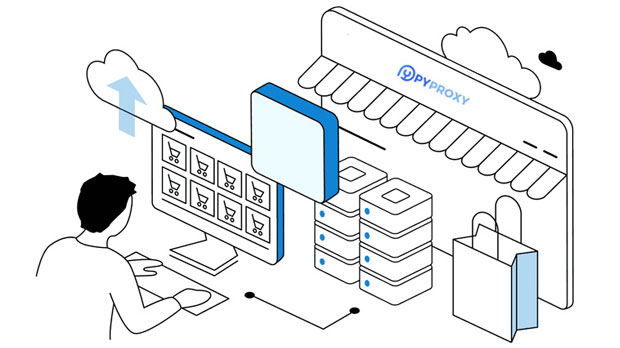When it comes to enhancing SEO performance through the use of proxies, choosing the right proxy provider is crucial. Two popular options in the proxy market are PYPROXY and Proxys. Both services claim to provide high-quality anonymous proxies, but which one is truly better suited for SEO tasks? SEO professionals rely heavily on proxies for tasks such as web scraping, keyword tracking, managing multiple accounts, and improving website rankings. Therefore, understanding the advantages and limitations of these two services will help users make informed decisions that benefit their SEO strategies. In this article, we will compare PyProxy and Proxys based on several critical factors relevant to SEO tasks. Understanding the Role of Proxies in SEOBefore diving into the comparison of PyProxy and Proxys, it’s important to understand the role proxies play in SEO. Proxies are essential for SEO professionals because they enable users to access the internet anonymously and bypass restrictions such as IP bans and geo-blocks. This is especially important for tasks like web scraping, where repeatedly making requests to a website from the same IP address can lead to temporary or permanent bans. By rotating IP addresses or using proxies from different regions, SEO professionals can avoid these issues.Proxies also help with tracking keyword rankings in various locations, conducting competitive analysis, and managing multiple social media or Google accounts simultaneously without raising suspicion. In short, proxies are a fundamental tool for managing SEO tasks efficiently and safely. Now, let’s examine how PyProxy and Proxys cater to these needs.What is PyProxy?PyProxy is a proxy service that provides rotating residential proxies, which are essential for anonymity and avoiding detection while performing SEO tasks. These proxies are particularly useful for activities like scraping search engine results, managing multiple accounts, and simulating user activity across different regions. PyProxy offers high-speed proxies that can easily rotate every few minutes or with every request, making it hard for websites to detect automated activity.One of the most significant benefits of PyProxy is its ability to provide proxies that appear as if they are from real residential users, making it almost impossible for websites to distinguish between legitimate users and bots. This reduces the risk of being blocked or flagged while engaging in SEO activities. PyProxy is also known for its high success rates in web scraping and keyword tracking.What is Proxys?Proxys, on the other hand, is a well-known provider that offers a wide range of proxy services, including datacenter proxies, residential proxies, and mobile proxies. Proxys emphasizes the quality of its proxies, offering both shared and dedicated proxies depending on user needs. The service is particularly popular for businesses and individuals who require a large number of IP addresses for tasks like market research, web scraping, and SEO.Proxys is known for providing proxies with high anonymity levels, which helps users avoid detection while carrying out various SEO tasks. With its vast pool of IP addresses across different locations, Proxys allows users to easily rotate proxies and manage multiple requests without facing IP bans or restrictions. However, Proxys also comes with certain limitations, such as the potential for slower speeds and some IP addresses that may be flagged as suspicious by certain websites.Key Factors to Consider for SEO TasksTo determine which proxy provider is better suited for SEO tasks, several key factors must be taken into account. These factors include the type of proxies offered, the speed and performance of the proxies, their level of anonymity, and the geographic coverage they provide.Proxy Types: Residential vs. Datacenter ProxiesOne of the most important distinctions between PyProxy and Proxys is the type of proxies they offer. PyProxy specializes in residential proxies, which are preferred for SEO tasks because they are less likely to be detected by websites. Residential proxies use IP addresses that are assigned to real users by Internet Service Providers (ISPs), which makes them appear more legitimate in the eyes of websites and search engines.Proxys, on the other hand, offers both residential and datacenter proxies. While datacenter proxies are often faster and more affordable, they are also easier to detect and block by websites that monitor suspicious behavior. For SEO purposes, residential proxies are typically the better choice because they provide a higher level of anonymity and are harder to block.Speed and PerformanceFor SEO tasks such as web scraping, keyword tracking, and competitive analysis, speed is a critical factor. The more efficient the proxy, the quicker the tasks can be performed without interruptions. PyProxy is known for its fast residential proxies, which are optimized for SEO tasks. Their rotating proxies can handle high volumes of requests, ensuring smooth performance for users.On the other hand, Proxys, especially its datacenter proxies, tend to be faster than residential proxies. However, datacenter proxies can also suffer from occasional speed fluctuations and are more likely to be flagged by websites, which can slow down performance. Overall, PyProxy’s residential proxies might offer better consistency and reliability for long-term SEO projects.Anonymity and IP RotationAnonymity is essential when using proxies for SEO, as websites and search engines can easily detect unusual patterns of behavior or multiple requests from the same IP address. PyProxy’s residential proxies excel in this area, offering high levels of anonymity and seamless IP rotation. The rotating proxies make it difficult for websites to detect automated activity, ensuring that SEO professionals can continue their tasks without facing restrictions or bans.Proxys also offers rotating proxies, but its datacenter proxies are more likely to be flagged by websites. This is especially true for tasks such as scraping search engine results or managing multiple accounts, where anonymity is key. While Proxys provides a variety of proxy options, PyProxy’s residential proxies are generally considered to be more effective at maintaining anonymity for SEO tasks.Geographic CoverageFor international SEO tasks, such as checking local rankings in different countries or scraping region-specific content, geographic coverage is another important factor. PyProxy offers a wide range of IP addresses from different regions, which is ideal for global SEO campaigns. The ability to simulate browsing activity from various locations allows SEO professionals to obtain more accurate and localized results.Proxys also offers global coverage, but its geographic spread may not be as extensive as PyProxy’s, particularly when it comes to residential proxies. Users looking for precise geographic targeting may find PyProxy’s offering more beneficial for SEO campaigns that require regional or local data.Cost-EffectivenessCost is always a consideration when choosing a proxy provider. PyProxy tends to be more expensive due to its focus on residential proxies, which are generally more costly than datacenter proxies. However, the added cost comes with the benefit of higher success rates and reduced risk of detection, which is particularly important for SEO tasks.Proxys, with its range of options, offers more flexible pricing. Datacenter proxies are typically more affordable, but they come with the trade-off of higher detection rates. Users who prioritize cost over anonymity may find Proxys to be a more budget-friendly option, although they may face challenges when it comes to certain SEO tasks that require high levels of anonymity.Conclusion: Which Proxy is Better for SEO?In conclusion, both PyProxy and Proxys offer valuable proxy services, but for SEO tasks, PyProxy is generally the better choice due to its focus on residential proxies, which provide higher levels of anonymity and better performance for tasks such as web scraping and keyword tracking. PyProxy’s rotating proxies offer excellent speed, low detection rates, and global coverage, making it the more suitable option for SEO professionals looking to maintain their rankings and avoid IP bans.However, Proxys can still be a good choice for users who require a more affordable option or those who need high-speed datacenter proxies for less demanding SEO tasks. Ultimately, the decision between PyProxy and Proxys depends on the specific SEO needs of the user, such as the level of anonymity required, budget, and the types of tasks to be performed.
Mar 28, 2025
![arrow]()




























































